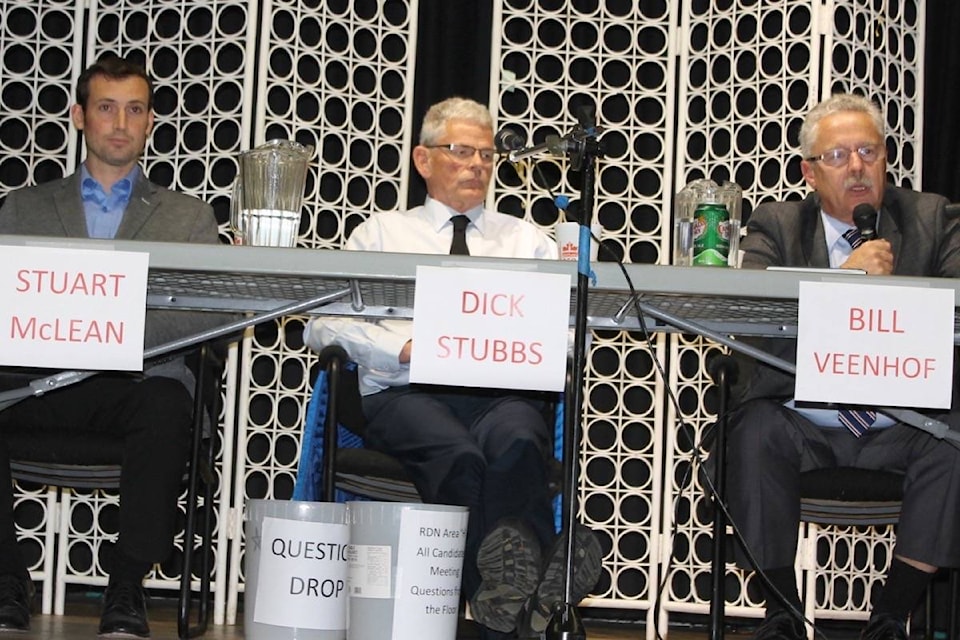The Bowser Sewer Project was a key issue residents listened to with keen interest at an Electoral Area H (Shaw Hill, Deep Bay, Bowser) all-candidates meeting at the Lighthouse Community Centre on Wednesday night.
Candidates Bill Veenhof and Stuart McLean were on hand to answer questions raised by residents.
The event, which drew close to 200 people, was organized by the Lighthouse Country Business Association (LCBA) and was mediated by Dick Stubbs. The LCBA provided 10 questions with the rest randomly chosen from members of the public.
The questions focussed on a variety of topics that included densification of Area H, how to help local businesses, and the Bowser Sewage Project.
The first question from LCBA to Stuart McLean drew laughter from the gallery.
With 90 seconds to respond, the question was “What have you been doing to prepare yourself for the role of Area H director and are you knowledgeable of the Official Community Plan (OCP), Regional District of Nanaimo (RDN) policies and procedures and as you work full-time, how would you arrange your schedule to accommodate the RDN meetings working with committees and the background research required for both Area H issues and the ones you will be voting on for the RDN as a whole plus what is your main goal?”
Stubbs quipped “boy that’s a mouthful.”
McLean said he has been talking with members of the public to learn what is important to them, read the OCP and familiarized himself with RDN procedures and attends meetings whenever he can in Nanaimo. He plans to work part-time if elected as it would give him the flexibility to arrange his schedule as he sees fit in order to perform his job as the region’s director.
Both candidates were asked what are the most important issues facing Area H and actions they would take to address them.
Veenhof sees housing affordability as a big issue in the region.
“That’s something you hear about all over the province,” he said. “But the simple fact is our age demographic is older and we’ve got to drive down housing prices or create housing affordable stocks so we can bring young people in. I am a firm believer of bringing in young people and using houses and housing affordability to do that.”
Making the region’s road right-of-way safer and bringing active transport corridors is another big issue and a challenge to address, said Veenhof, along with traffic calming.
McLean cited “challenging any attempt to release sewage or other waste into the Salish Sea, I will push to change the current Bowser Sewage Project to a land base disposal. I will be making monthly open meeting availability to constituents because it’s important that you actually see your representative. I will be developing an Area H commission and will be examining the Area H OCP regarding density transfers, cluster development and the effects on the rural character of the region.”
A question from a resident asked the candidates whether they are aware of less-costly and environmentally friendly alternatives to the marine outfall proposal for the Bowser Sewer Project.
McLean indicated he is aware of the availability of viable alternatives to marine outfall.
He said that there are innovative disposal systems readily available that have been put in place around the world that can protect groundwater.
“As your new director, I will implement a modern disposal system that may very well save money,” he said. “I will work with the community to ensure that all future sewage projects follow this model. I believe that the people of Area H deserve better than what we’ve been offered.”
Veenhof said he researched the issue when it first came up and had directed RDN staff for a report on a land disposal option. Four areas he cited were explored in Area H and were all not suitable for land disposal system.
“Any ground base disposal risks our groundwater. We can’t go down that road,” said Veenhof.
“There is only one ground base disposal site on Vancouver Island. It has failed…. of similar size. It’s Arbutus Ridge. And at a tremendous cost to the taxpayers, they had to replace it. Ocean plastics were mentioned, secondary treatment removes 99 per cent of the plastics in the water.”
Not all the questions were read and Stubbs said that they will be handed to the candidates and their responses will be put online at the LCBA website at http://lighthousecountry.ca/.
